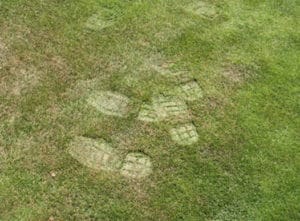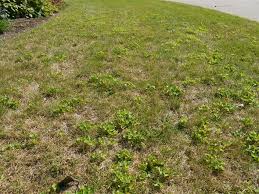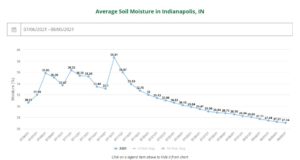Drought Stress And Heat Damage In Cool Season Lawns
Lets Talk About Drought Stress And Heat Damage.

Here in Central Indiana, we are pretty well adjusted to the large swings in weather conditions that often occur. Our lawns however, are not. Cool season grasses such as tall fescue and bluegrass are especially susceptible to drought stress and heat damage, and prefer a window of temps between 55 and 75 degrees. Cooler weather triggers a slowdown in metabolic processes that signal hibernation. But temperatures above that range cause stress, which can lead to a multitude of problems. Heat stress in the lawn can lead to severe damage caused by fungus and disease, insect invasion and even light traffic. In the picture above, we can see the effects of walking on a heat stressed lawn. Notice that the blades of grass have not sprung back up. This is because the plant has become so hot, baking under a summer sun, that it has stopped sending water up from the roots to the blade (respiration). This is a defensive measure meant to conserve water. But respiration in a plant is one of the ways a lawn moderates its temperature, much like us when we sweat. The evaporating moisture cools the lawn by up to 20 degrees compared to the air temperature on a hot day.
Heat Stress Leads To Damage
Heat stress can cause the lawn to lose its ability to resist traffic, fungus and disease. As the lawn stresses, it slows its rate of growth dramatically. This allows fungi to outgrow the lawn and cause visible and lasting damage. It increases the probability of disease such as blight and summer patch/brown patch. And it prevents the lawn from repairing damage caused by traffic. Even with a professional treatment service, this damage can take place. In the picture above, you can see the damage caused by driving the mower on the lawn on a hot, dry day. This lawn has been treated and taken care of, but has not been irrigated properly, allowing the damage to take hold. This could have been avoided by following a proper watering schedule and a little bit of mindful observation.
Heat Stress Leads To More Weeds

When the lawn stresses due to heat stress and drought, the roots and crown recede. this opens up territory for weeds to take control. These weeds are naturally able to withstand these dry, hot conditions. They have evolved the ability to slow their metabolic processes during times of extreme conditions, allowing them to survive and even thrive. This process has an added side effect, making them more resistant to lawn safe herbicides that are typically used during the summer months. By allowing your lawn to become an arid and dry microsystem, you are creating a perfect habitat for weeds like thistle, spurge and crabgrass.
Watering Is Essential

There is one way to prevent drought stress and heat damage. Watering the lawn. Water is the most important aspect of a lawns needs, and the key ingredient to any and every treatment plan on the market. But natural rainfall isn’t always enough. A proper watering schedule and mowing practices will keep the lawn hydrated, allowing the metabolic growth processes to keep up with damage and disease, minimizing damage. Cool season lawns need a minimum of 1 inch of irrigation per week, and up to 3 inches of irrigation during hot, dry weather. The best watering schedule is one that takes place early in the morning, just after sunrise and alternates watering to every other day. The amount of time depends on your particular watering system, but should deliver 3/4 of an inch of irrigation per session. This is the minimum requirement of the lawn, and will prevent dormancy and ease stress. The graph below shows the steady decline in soil moisture content for the last 30 days, detailing the growing need for water in the lawn.
